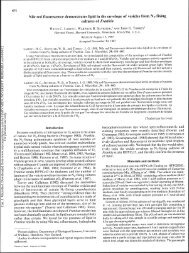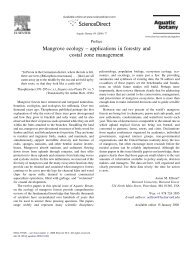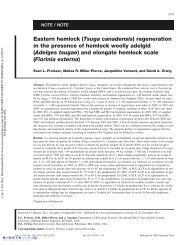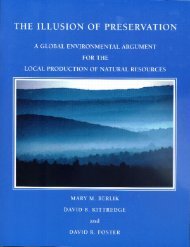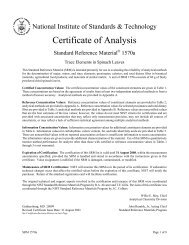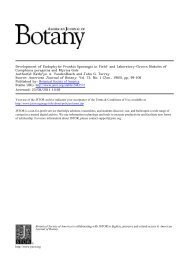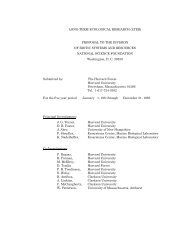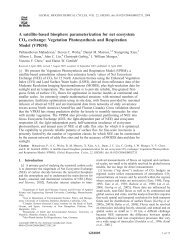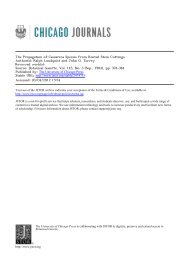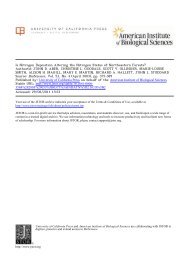Abstracts of Papers - Harvard Forest - Harvard University
Abstracts of Papers - Harvard Forest - Harvard University
Abstracts of Papers - Harvard Forest - Harvard University
Create successful ePaper yourself
Turn your PDF publications into a flip-book with our unique Google optimized e-Paper software.
in the septa between the carpels. Although crystal sand<br />
can be found in cells <strong>of</strong> the ovary and prismatic crystals in<br />
leaf idioblasts, only druses are found in the zones asso-<br />
ciated with abscission or dehiscence. The druses are found<br />
in the abscission zones at relatively early stages long<br />
before abscission is to occur. The druses (a multiple array<br />
<strong>of</strong> twin crystals arranged in a spherical space) develop<br />
within the vacuole <strong>of</strong> the crystal idioblasts. The druses<br />
vary somewhat in size and morphology and in the structure<br />
<strong>of</strong> the individual crystals which make up the druse. In<br />
some cases crystals are sharply pointed, in other cases they<br />
are less pointed or even rounded. As the crystals <strong>of</strong> the<br />
druse develop some appear to press through the cytoplasm<br />
and grow near the cell wall. Later in development a cell<br />
wall-like sheath grows around the crystal. Whether this is a<br />
response to the crystal penetrating the cytoplasm and<br />
appressing the cell wall is not yet clear. The cell wall-like<br />
sheath can easily be seen by electron microscopy and<br />
appears similar to the primary wall. Isolated crystals may<br />
still be encased by this sheath. Once the sheath is<br />
complete the crystal is sealed <strong>of</strong>f from the remainder <strong>of</strong><br />
the still living cell. After the organ has abscissed the<br />
crystal remains just below the scar left by abscission. The<br />
concentration <strong>of</strong> crystals at this point suggests a possible<br />
protective role for the crystals. Obviously this may be a<br />
secondary "function" in that the crystals may play a more<br />
meaningful role in calcium metabolism prior and during the<br />
formation <strong>of</strong> the abscission layer.<br />
JENSEN, WILLIAM A.*, MARIE MIZELLE, RAVINDER<br />
SETHI and MARY ASHTON. Department <strong>of</strong> Botany,<br />
<strong>University</strong> <strong>of</strong> California, Berkeley, CA 94720.<br />
- Pollen development in wheat treated with a<br />
chemical hybridizing agent.<br />
Triticum aestivum seedlings were treated with a<br />
chemical hybridizing agent developed by Rohm and Haas<br />
Chemical Company known as RHOO07. It caused the<br />
pollen to abort without markedly affecting the fer-<br />
tility <strong>of</strong> the ovule. Ultrastructural and histo-<br />
chemical studies revealed the compound specifically<br />
inhibited the formation <strong>of</strong> sporopollenin. This<br />
inhibition was not complete but the pollen in treated<br />
plants laid down a wall only 1/3 as thick as that<br />
found in the control. Histochemical studies indicate<br />
that it is not the synthesis <strong>of</strong> the carotene subunits<br />
but the polymerization step that is inhibited.<br />
JENSEN, WILLIAM A.*, MARIE MIZELLE, RAVINDER SETHI<br />
and MARY ASHTON. Department <strong>of</strong> Botany, <strong>University</strong><br />
<strong>of</strong> California, Berkeley, CA 94720. - Ultrastructural<br />
study <strong>of</strong> pollen development in wheat.<br />
A study <strong>of</strong> pollen development in Triticum aestivum<br />
was made using the electron microscope. The study<br />
began with the microspore mother cell and continued<br />
to the mature pollen. Stress was placed on the<br />
changes in the cytoplasm during the various developmental<br />
stages, as well as oni the wall. Marked<br />
changes in ribosome number, plastid size and shape,<br />
and amounts <strong>of</strong> ER were noted at various stages.<br />
The quantity <strong>of</strong> wall deposited was also studied in<br />
detail. This study forms the foundation for the<br />
data presented in the subsequent work on a chemical<br />
hybridizing agent.<br />
KANE, MICHAEL E.* and LUKE S. ALBERT. Department<br />
<strong>of</strong> Botany, <strong>University</strong> <strong>of</strong> Rhode Island,<br />
02881. - Effects <strong>of</strong> ABA on-heterophylly<br />
Kingston, RI<br />
and stomatal<br />
development on submerged juvenile shoots <strong>of</strong><br />
Myriophyllum heterophyllum Michx.<br />
In the heterophyllous aquatic angiosperm M. hetero-<br />
Developmental and Structural Section 23<br />
phyllum, submerged juvenile shoot apices develop dis-<br />
sected astomatous leaves that are composed <strong>of</strong> fili-<br />
form divisions consisting <strong>of</strong> a compact mesophyll. In<br />
contrast, aerial juvenile apices develop smaller and<br />
thickened pinnatisect leaves which bear adaxial sto-<br />
mata in a cutinized epidermis and lacunae within the<br />
mesophyll. Results <strong>of</strong> recent investigations on the<br />
physiological control <strong>of</strong> submerged and emergent forms<br />
in two other heterophyllous aquatics suggest a role<br />
for water-stress induced formation <strong>of</strong> abscisic acid<br />
(ABA) in the development <strong>of</strong> aerial leaf morphologies.<br />
To determine whether ABA also plays a role in the de-<br />
velopment <strong>of</strong> the aerial juvenile phase <strong>of</strong> M. hetero-<br />
phyllum, axenic cultures <strong>of</strong> the submerged juvenile<br />
phase were grown in a liquid medium consisting <strong>of</strong><br />
Murashige and Skoog salts, vitamins, and 3% sucrose<br />
with or without ABA (10-9 to 10-4M) at 25 C in a 16<br />
hr photoperiod (PAR; 200 uE m-2s-l) for 10 days. Con-<br />
trol plants produced astomatous leaves typical <strong>of</strong> the<br />
submerged growth phase while exposutre to 10-6, 10-5,<br />
or 10-4 M ABA induced the formation <strong>of</strong> leaves morpho-<br />
logically and anatomically similar to those on aerial<br />
juvenile shoots. The influence <strong>of</strong> ABA on adaxial<br />
stomatal development was evident by observed increases<br />
in stomatal densities with hormone concentration (23,<br />
100, 150, and 154 stomates/mm2 for plants exposed to<br />
10-7, 10-6, 10-5 and 10-4 M ABA, respectively.) The<br />
hormone ABA therefore appears to play an important<br />
role in the control <strong>of</strong> heterophylly and stomatal<br />
development in an increasing number <strong>of</strong> aquatic<br />
angiosperms.<br />
KAUL, ROBERT B. School <strong>of</strong> Life Sciences,<br />
<strong>University</strong> <strong>of</strong> Nebraska, Lincoln NE 68588.<br />
-Inflorescence architecture and evolution in<br />
Asiatic Fagaceae.<br />
More than 200 Far Eastern species <strong>of</strong> Castanea,<br />
Castanopsis, Lithocarpus, and Quercus have been<br />
examined. Flowers are borne on spikes that are<br />
axillary to leaves and bracts <strong>of</strong> the current and<br />
previous seasons' stems. The spikes are <strong>of</strong>ten<br />
unisexual and male spikes greatly outnumber females<br />
on a tree. Some spikes, however, are androgynous,<br />
gynecandrous, or androgynecandrous, and all three<br />
conditions can occur on a single tree. Various<br />
degrees <strong>of</strong> separation <strong>of</strong> the sexes and <strong>of</strong> aggrega-<br />
tion <strong>of</strong> spikes into reproductive short-shoots exist.<br />
Some short-shoots have abortive apices and others<br />
produce monopodial continuation growth. Sometimes<br />
both kinds occur on the same individual, in which<br />
cases the determinate short-shoots are below the<br />
indeterminates and ordinarily bear only male flowers;<br />
the determinates usually bear a few female flowers<br />
in their distal spikes. More or less paralleling<br />
these phenomena is reduction from foliage leaves to<br />
bracteoles on the short-shoots. The most extreme<br />
condition occurs in Quercus, where the short-shoots<br />
are always unisexual, determinate, and only bract-<br />
eolate, and male flowers are borne on pendulous<br />
spikes (catkins).<br />
KAUSCH, A.P.* and H.T. HORNER. Department <strong>of</strong><br />
Botany, Iowa State <strong>University</strong>, Ames, IA 50011.<br />
- Increased nuclear DNA content during raphide<br />
crystal idioblast development in Vanilla plani-<br />
folia L.<br />
Files <strong>of</strong> calcium oxalate raphide crystal idioblasts<br />
are formed in the cortex <strong>of</strong> adventitious roots <strong>of</strong><br />
Vanilla planifolia L. Idioblast initials are first<br />
recognized by intense fluorescence <strong>of</strong> the cytoplasm<br />
with the acridine orange method. Nuclear and nucleo-




